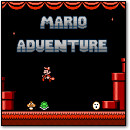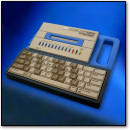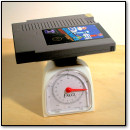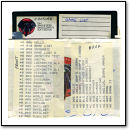[ Retro Scan of the Week ] Apple II SwyftCard
Monday, March 30th, 2015 Paid for by SwyftCard Veterans for Truth
Paid for by SwyftCard Veterans for Truth
From the land of exotic Apple II accessories comes the Information Appliance SwyftCard, a plug-in peripheral card that gave the Apple IIe a built-in suite of ROM-based productivity tools, all unified around a novel scroll-based [PDF] user environment called SWYFT.
SWYFT was the brainchild of former Apple employee Jef Raskin, who originally spearheaded the Macintosh project. After disagreements with Steve Jobs over the direction of that project, Raskin left Apple and founded Information Appliance, Inc. (consequently, Jobs took the Mac project in a completely new direction).
The SwyftCard originated as an Apple IIe-based prototype for a dedicated machine centered around Raskin’s SWYFT environment, but it proved so effective and compelling that it became its own product. The dedicated concept would later emerge as the Canon Cat in 1987.
SwyftCards are very rare (I’ve never seen one in person over 20 years of collecting Apple II hardware), so Apple enthusiast Mike Willegal has provided instructions for building your own. Pretty neat!
P.S. I emailed this ad to Steve Wozniak (who is featured in the ad) and he said, “Cool reminder!”
Discussion Topic of the Week: Jef Raskin vs. Steve Jobs: Who do you identify with the most?
[ Retro Scan of the Week ] HI-RES ADVENTURE #4: Ulysses and the Golden Fleece
Monday, March 23rd, 2015Discussion Topic of the Week: What’s your favorite static-screen graphical adventure game of all time?
[ Retro Scan of the Week ] The Nintendo Smartwatch
Monday, September 15th, 2014 Why not put LZDN1WBF and LSMN1WBF on your Xmas wishlist?
Why not put LZDN1WBF and LSMN1WBF on your Xmas wishlist?
As you probably know, Apple recently introduced the Apple Watch. That got me thinking about other nerdy watches of yore, and I remembered something I recently found in my mom’s attic.
Last month, my mother and I searched through boxes and boxes of my grandmother’s old dishes to see what might be of use to me now. The dishes had been sitting in my parents’ attic untouched for two decades. Many of them were padded with old newspaper from eastern Tennessee, which is where my grandmother lived until she died in 1992.
Among the usual black-ink-on-yellowing-paper fare, I found a handful of gloriously full-color advertisement circulars. A December 1989 mini-catalog for Service Merchandise caught my attention immediately because it featured a pair of Nelsonic Game Watches licensed by Nintendo. (That segment of the circular is what you see scanned above.)
Each of these two watches, which sold for ($19.97 a piece — or $38.37 today when adjusted for inflation) played a simplified prefab-LCD interpretation of its console namesake. If you remember Tiger’s LCD handheld games, you’re on the right track. In the Zelda watch game, you were forever trapped in a dungeon, and in Super Mario Bros. you forever hopped between platforms.
While these watch games were limited at the time, it was amazing to think you could fit a portable, battery-powered “video game” on your wrist and play it wherever you liked. I personally recall seeing more than one of these watches getting confiscated by teachers during my elementary school days.
That desire to carry functional video games with us has never abated. Heck, I bet that within days of the Apple Watch’s release next year, someone will hack it to play emulated versions of Super Mario Bros. and The Legend of Zelda — allowing us to finally have the full NES experience on our wrists. It may be 25 years too late, but it will be amusing to see how things have come full circle.
Discussion Topic of the Week: Have you ever owned a watch that played a game? Tell us about it.
Macworld Magazine (1984-2014)
Wednesday, September 10th, 2014 In Memoriam: Macworld Magazine, print edition (1984-2014)
In Memoriam: Macworld Magazine, print edition (1984-2014)
Today I found out that Macworld will cease to be a print magazine and that many of my friends and colleagues have been laid off. Macworld.com will continue to exist, albeit with a relative skeleton crew.
It’s very sad to see a day like this come (especially when I still look forward to a new issue of Macworld coming in the mail every month — one of the last print publications I read), but all things must come to an end. It is amazing, in retrospect, that Macworld magazine remained a constant, intelligent voice amid the chaos of a rapidly churning computer industry for thirty years.
Thirty years. Think of all the change that has happened in that time — the tech uphevals, the revolutions, the fall and rise of Apple, the Jobs-as-Phoenix, and rapid spread of the Internet — and through it all, Macworld has been there.
So thank you, Macworld, for serving the Mac community so well. And thanks to its staff in particular. I’d especially like to express my gratitude to Roman Loyola, Jason Snell, Dan Moren, Dan Frakes, Dan Miller, and Philip Michaels (among many others) for their wonderful work on the publication, and their genuine humanity, decency, patience, and fairness (sometimes rare qualities in an editor) through the years.
Roman Loyola, in particular, has been my go-to guy to get my — nay, our — particular brand of Apple history work pushed out to the world, and I am immensely grateful to have worked with him.
The talent pool of editorial labor laid off from Macworld today is immense, and other publications would be fools not to snatch them up as quickly as they can.
As for me, I’ve been contributing to the publication since 2008. As long as Macworld.com is still around, I might still write things for it. (Completely gutting a publication of its beloved veteran staff doesn’t exactly inspire confidence in the future, however.) Time will tell. Until then, it’s been a great ride.
[ Retro Scan of the Week ] Aplus 3000 Apple II Clone
Monday, August 25th, 2014 Everything looks cheaper in black and white print.
Everything looks cheaper in black and white print.
The IBM PC wasn’t the only American microcomputer that got cloned in the 1980s. The Apple II also inspired its fair share of software-compatible copycats, such as the Aplus 3000 system seen here.
This appears to be a grey market VTech Laser 3000 computer with the name plate removed — possibly to avoid any trade import bans on Apple II clones that may have existed at the time.
Clones like this were popular in certain underground circles, and for good reason. Take a look at the price list in the ad. The Aplus 3000 retailed for US $499 (about $1,104 today when adjusted for inflation) verses $1745 for a bona fide Apple IIe (about $3,863 today). And on top of that, the Aplus 3000 contained integrated peripheral cards that would cost thousands of extra dollars if purchased separately for use in a real Apple IIe.
As I’ve mentioned before, peripheral integration was a great way to undercut official products. It happened quite a bit in the IBM PC universe.
Discussion Topic of the Week: If you could buy an unauthorized clone of an iPad or iPhone that ran iOS and had better specs for less price, would you do it?
—
See Also: Orange+Two Apple II Clone (RSOTW, 2010)
See Also: Apple II Box for C64 (RSOTW, 2013
See Also: How I Got My First Computer, and How I Got My First Computer Back
[ Newsbits ] June 6, 2014
Friday, June 6th, 2014

Despite what you may think, Newsbits is not dead. It just needs more fiber.
Recent News
- The RetroN 5 Launching June 6th (Today!) in the US
(Source: Destructoid)Hope it works as advertised.
This thing is a beast, supporting NES, Famicom, SNES, Super Famicom, Genesis, Mega Drive, Game Boy, Game Boy Color, and GBA cartridges. All of that, with 720p output via HDMI and original controller support.
- Wii U plugs first DS game into Virtual Console in Japan
Once upon a time, Nintendo frowned strongly upon emulation. Now its business model depends on it. Oh, how times have changed.
Puzzle-poser Brain Age is the first DS game to arrive on Wii U Virtual Console, and it’s out now in Japan for free until June 30.
- Unearthed E.T. Atari games will be curated by New Mexico space museum and then sold
(Source: Polygon)A unique situation where one of these games in unopened, mint condition could be worth far less than one crushed and buried in a landfill for 30 years.
Seven hundred of the 1,300 E.T. and other Atari cartridges recovered from a New Mexico landfill will be appraised, certified and put up for sale, the Alamogordo City Commission decided this week.
- The Verge Publishes Rarely-Seen Photos of Apple’s 1980s Prototype Case Designs
(Source: The Verge)Incredible photos of early 1980s Apple products that never were
Some of its earliest and most iconic designs, however, didn’t actually come from inside of Apple, but from outside designers at Frog. In particular, credit goes to Frog’s founder, Hartmut Esslinger, who was responsible for the ‘Snow White’ design language.
- Watching kids trying to figure out how to use an old Apple II is totally hilarious
(Source: Cult of Mac)
This video of children from the ages of 6 to 13 trying to figure out how to work a vintage Apple II … shows just how inexplicable computing was to pretty much everyone before Steve Jobs released the original Mac in 1984.
- Modder Stuffs a Raspberry Pi into a Game Boy Pocket
(Source: Hackaday)This is one of the most amazing mods I’ve ever seen
After sanding down the bosses on the inside of the case, gluing the battery door shut, and installing a bit of plastic over the cartridge slot, WarriorRocker was able to fit a Raspi inside. The buttons use the same PCB as the stock Game Boy, connected to a Teensy 2.0 board that simulates a USB keyboard.
- Exhibiting .gifs: An Interview with curator Jason Eppink
(Source: The Signal)Wonder if they know about Retro GIF of the Week
Jason recently curated ‘The Reaction GIF: Moving Image as Gesture,’ which exhibits a set of GIFs he identified in consultation with redditors.
Cool Links
- Where Have You Gone, Peter Norton?
(Source: Technologizer)A look back at the PC utility guru’s career by Harry McCracken at the newly-reborn Technologizer
Norton’s empire grew to include multiple software products, articles (including a long-running PC Magazine column), and books. He was everywhere that PCs were. And then, in 1990, he sold Peter Norton Computing to Symantec, which made the Norton line of software even more successful.
- Wolfenstein game graphics, 1992 vs 2014
(Source: Twitter)A million more pixels, but the jaw remains the same
- The Most 90s Thing That Could Ever Exist
(Source: The Atlantic)
The zeitgeist summed perfectly in one technological artifact, which is a VHS tape promoting Windows 95, starring Jennifer Aniston and Matthew Perry.
- Total Chaos is the Best-Looking Doom II Mod You’ve Ever Seen
(Source: PCGamer)More like a “GZDoom mod,” but still very impressive.
Total Chaos doesn’t run on the Doom 2 engine from 1993 proper, but a modified version of the original source code that brings in OpenGL, mouse looks and other features like 16x motion blur, high resolution textures, 3D models, and bloom effects.
- The Secret History of Hypertext
(Source: The Atlantic)
Historians of technology often cite Bush’s essay as the conceptual forerunner of the Web. And hypertext pioneers like Douglas Engelbart, Ted Nelson, and Tim Berners-Lee have all acknowledged their debt to Bush’s vision. But for all his lasting influence, Bush was not the first person to imagine something like the Web.
- The Woman Behind Apple’s First Icons
(Source: Priceonomics)…and Windows 3.0 to XP’s Solitaire cards! (I did an interview with her about that once, gotta find it.)
For many, Susan Kare’s icons were a first taste of human-computer interaction: they were approachable, friendly, and simple, much like the designer herself. Today, we recognize the little images — system-failure bomb, paintbrush, mini-stopwatch, dogcow — as old, pixelated friends.
Submit News
If you want me to include something on a future Newsbits column, send me an email with “Newsbits” in the subject line.
[ Retro Scan of the Week ] Performa: The Depressing Macintosh
Monday, June 2nd, 2014The Performa line originated as a way for Apple to expand retail availability of its then-waning Mac platform. They did so by re-branding a number of existing Mac models with the Performa name (plus some numbers that didn’t make much sense).
The Performa line’s commercial availability coincided almost exactly with Apple’s darkest era, 1992-1997, when sales dramatically declined, market share dropped, the company was generally mismanaged and unfocused, Macs had 10 different names for the same model, and Classic OS was getting long in the tooth.
I remember seeing a few Performa models for sale at Sears as a teenager and thinking, “Wow, they still make Macs?” Then I tried one out, and the OS was barely different from the Mac SE I’d last used in 1987 — some 6 years earlier — and it liked to crash a lot. It was a depressing time to be Apple. Whatever happened to that company, anyway?
Discussion Topic of the Week: What was the first model of Macintosh you ever owned?
[ Newsbits ] May 15, 2014
Wednesday, May 14th, 2014

Since I missed last week’s column, I decided to fold some of those links into this week’s edition. So there may be a few older newsbits, but at least they’re still interesting.
Recent News
- 2300 Console Games Now Playable on Internet Archive
‘Ole pal Jason Scott writes about the sudden influx of games playable on the Internet Archive website
For the last couple of weeks I’ve been working with a range of volunteers on a massive expansion of what we call the Console Living Room at the Internet Archive. Previously weighing in at about 800 game cartridges from seven console systems, the new collection is roughly 2300 cartridges and a total of 21 different consoles.
- George R. R. Martin Writes Using WordStar 4.0 in MS-DOS
I’m not surprised. To avoid distractions, I sometimes write using Word 6.0 for DOS on a Compaq Aero 4/25 laptop.
The ‘Game of Thrones’ author confessed to late-night talk-show host Conan O’Brien that he prefers to write his popular books on a DOS word processor instead of the latest laptop.
‘I hate some of these modern systems where you type a lower case letter and it becomes a capital letter. I don’t want a capital. If I wanted a capital, I would have typed a capital. I know how to work the shift key.’
- Nintendo Forces Takedown of GBA Emulator for iOS
From the not-very-surprising department
In order to play titles like Super Mario and Zelda on your iPhone, then, you have to look at unofficial alternatives. GBA4iOS was one of the most popular — but after its creators received a DMCA notice from Nintendo this week, it is no more.
- Analogue Interactive’s $499 NES Clone Up for Pre-Order
TinyCartridge reports on this fancy console with a healthy grain of salt mixed in. (Memories of Generation NEX still make me shudder.)
Analogue has opened pre-orders for its Nt, the Famicom/NES device with RGB output, four controller ports, and purported ‘unparallelled'” compatibility with American and Japanese games and accessories.
- New Book About How Sega Nearly Won the Console Wars
Chris Kohler provides an overview of Console Wars: Sega, Nintendo and the Battle That Defined a Generation.
If a few small things had changed, might we be gaming on a Sega PlayStation right now? That’s the picture Blake Harris paints in his new book Console Wars. It is a narrative history of the brief time period in the lifespan of the videogame publisher Sega when it was on top of the world.
- Midway Planned HD Remakes of Mortal Kombat Games
I would have really loved to see this
With the [ Mortal Kombat Arcade Kollection], Midway’s initial plan was to release HD remakes of the original games with new actors, and even though that’s not what happened in the end, these images with Liu Kang, Sonya, Shao Kahn and the others show that the remakes would have been quite faithful to the original
Cool Links
- The Last Survivors of Meridian 59
A rare examination of obscure Internet game culture from a mainstream publication (The New Yorker)
Today, almost eighteen years after Meridian 59’s launch, Barloque’s streets are quiet and vacant, its cobblestones buffed and rounded by little more than a digital breeze. They are rarely visited by more than twenty people in the world at any one time.
- The Great Works of Software
Paul Ford muses about a software canon
Is it possible to propose a software canon? To enumerate great works of software that are deeply influential—that changed the nature of the code that followed?
- How Steve Wozniak Wrote BASIC for the Original Apple From Scratch
Woz himself writes for Gizmodo, re: BASIC 50th anniversary
The problem was that I had no knowledge of BASIC, just a bare memory that it had line numbers from that 3-day high-school experience. So I picked up a BASIC manual late one night at HP and started reading it and making notes about the commands of this language. Mind that I had never taken a course in compiler (or interpreter) writing in my life.
- How Sega is Rejuvinating its Classic Games in 3D
I’m not sure if “rejuvenating” is the right word here, but I welcome Sega dipping into the past
Few games have had as much attention lavished upon them as the Sega 3D Classics series. The first wave of titles was released between November and December of last year, in pairs over four successive weeks.
- Super Mario Bros. Level Belt (Etsy)
Incredible artistry — an entire Super Mario Bros. level crafted into a leather belt
The images are of a belt that I crafted for my brother, who is a big Super Mario fan, and depicts the last level of Super Mario brothers where Mario finally rescues the princess.
Submit News
If you want me to include something on a future Newsbits column, send me an email with “[Newsbits]” in the subject line.
[ Retro Scan of the Week ] Crystal Quest for Game Boy
Monday, April 21st, 2014Fans of early Mac games will no doubt remember Crystal Quest, which (I believe) was the first Mac game to use color graphics just after the Mac II came out in 1987.
Crystal Quest on the Mac played like a space-based Robotron: 2084 controlled with the mouse, albeit with a loose trackball feel because your ship kept moving in the direction you nudged the mouse until you corrected its course. So I’m not sure how it played in this obscure Game Boy port from 1991. Perhaps I’ll fire up an emulator right now and find out.
Discussion Topic of the Week: Can you think of any other game that started on the Macintosh then received a port to a Nintendo console?









